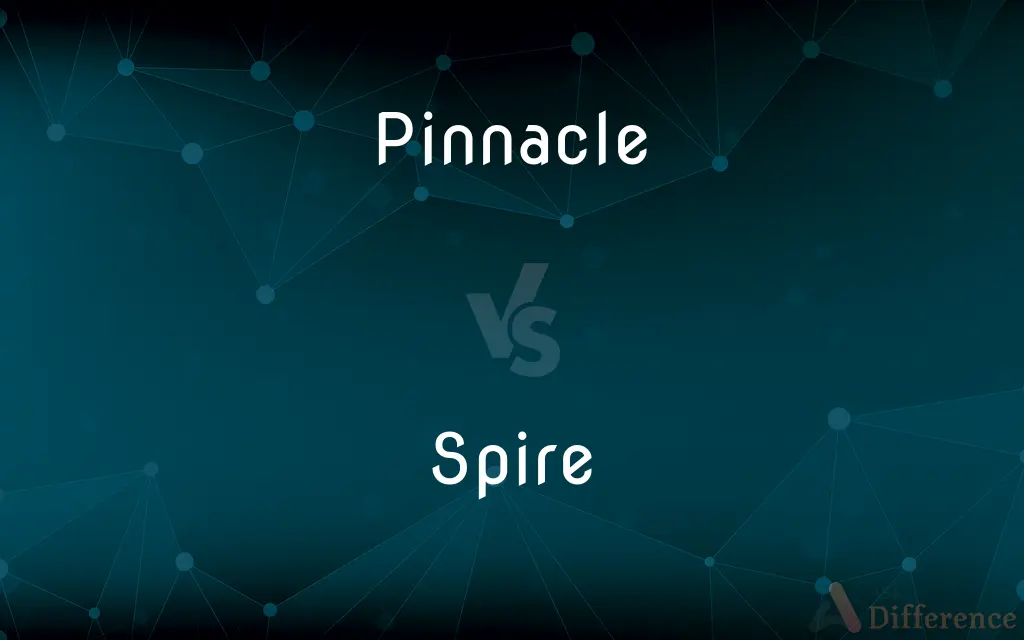Pinnacle vs. Spire — What's the Difference?
By Fiza Rafique & Urooj Arif — Updated on March 28, 2024
Pinnacle refers to the highest point or peak, especially of success or achievement, while spire is a tapering conical or pyramidal structure on the top of a building.

Difference Between Pinnacle and Spire
Table of Contents
ADVERTISEMENT
Key Differences
Pinnacle signifies the highest level or degree of something, often used metaphorically to describe the peak of achievements, career, or aspirations. It represents a point of success or excellence that is difficult to surpass. For example, winning an Olympic gold medal might be considered the pinnacle of an athlete's career. In contrast, a spire is a specific architectural feature, usually found atop churches, cathedrals, or skyscrapers, pointing skyward. It is not only a structural element but also often serves as a symbol, reaching towards the heavens or signifying aspiration.
While "pinnacle" can refer to both literal and figurative peaks, such as the summit of a mountain or the zenith of one's achievements, "spire" is primarily used in architectural contexts. An example of a pinnacle in a natural setting is the highest point of a mountain, whereas a spire is observed in the design of the Chrysler Building, emphasizing its architectural elegance and height.
The term "pinnacle" is versatile, applicable in various contexts to denote the highest or most important point of something. This can range from physical locations to levels of accomplishment. On the other hand, spires are closely associated with Gothic architecture, serving not only as decorative elements but also as symbols of reaching towards divine or lofty ideals.
In architecture, a pinnacle can also be a small, pointed turret or similar structure on a building, which differs from a spire in terms of size and function. Pinnacles are often used to add decoration to buildings, while spires contribute significantly to a building's overall profile and skyline presence.
Despite these differences, both terms share a thematic connection to height, aspiration, and prominence. Whether discussing the pinnacle of a career or the spire of a cathedral, both convey notions of reaching upward or achieving a significant standing.
ADVERTISEMENT
Comparison Chart
Definition
The highest point or peak, especially of success or achievement.
A tapering conical or pyramidal structure on the top of a building.
Context
Can be used metaphorically or literally.
Primarily architectural.
Example Usage
Refers to the summit of a mountain or the peak of one’s career.
Found atop churches, cathedrals, or skyscrapers.
Symbolism
Represents success, achievement, or excellence.
Symbolizes aspiration, reaching towards the heavens.
Architectural Use
Sometimes refers to a small, pointed turret on buildings.
A key element influencing a building’s profile and skyline.
Compare with Definitions
Pinnacle
The highest point of development or achievement.
Receiving the Nobel Prize is considered the pinnacle of a scientist's career.
Spire
A tapering conical or pyramidal structure on the top of a building.
The church’s spire could be seen for miles around, dominating the skyline.
Pinnacle
In architecture, a small, pointed turret or part.
The castle's roof was adorned with pinnacles, adding to its majestic appearance.
Spire
Used to enhance the vertical lines of structures.
The addition of a spire made the building the tallest in the city.
Pinnacle
A pointed formation or peak.
The mountaineer aimed to reach the pinnacle before sundown.
Spire
Architecturally significant as a symbol of aspiration.
The cathedral's spire, reaching towards the sky, inspires thoughts of the divine.
Pinnacle
Symbolizing the utmost level of excellence.
His latest novel is seen as the pinnacle of literary success.
Spire
Often associated with religious or spiritual buildings.
Many medieval churches are distinguished by their tall spires.
Pinnacle
The peak or topmost point of something.
The invention marked the pinnacle of the technological revolution.
Spire
A feature contributing to the aesthetic and symbolic height of buildings.
The modern skyscraper features a glass spire, adding to its elegance.
Pinnacle
A pinnacle is an architectural ornament originally forming the cap or crown of a buttress or small turret, but afterwards used on parapets at the corners of towers and in many other situations. The pinnacle looks like a small spire.
Spire
A spire is a tall, slender, pointed structure on top of a roof or tower, especially at the summit of church steeples. A spire may have a square, circular, or polygonal plan, with a roughly conical or pyramidal shape.
Pinnacle
The most successful point; the culmination
He had reached the pinnacle of his career
Spire
A top part or structure that tapers upward, such as a rock formation or steeple.
Pinnacle
A high, pointed piece of rock.
Spire
A slender, tapering plant part.
Pinnacle
Form the culminating point or example of.
Spire
A spiral.
Pinnacle
Set on or as if on a pinnacle.
Spire
A single turn of a spiral; a whorl.
Pinnacle
(Architecture) A small turret or spire on a roof or buttress.
Spire
The area farthest from the aperture and nearest the apex on a coiled gastropod shell.
Pinnacle
A tall pointed formation, such as a mountain peak.
Spire
To furnish with a spire.
Pinnacle
The highest point; the culmination.
Spire
To rise and taper steeply.
Pinnacle
To furnish with a pinnacle.
Spire
The stalk or stem of a plant.
Pinnacle
To place on or as if on a pinnacle.
Spire
A young shoot of a plant; a spear.
Pinnacle
The highest point.
Spire
Any of various tall grasses, rushes, or sedges, such as the marram, the reed canary-grass, etc.
Pinnacle
(geology) A tall, sharp and craggy rock or mountain.
Sea stack
Spire
A sharp or tapering point.
Pinnacle
(figuratively) An all-time high; a point of greatest achievement or success.
Spire
(architectural element) A tapering structure built on a roof or tower, especially as one of the central architectural features of a church or cathedral roof.
The spire of the church rose high above the town.
Pinnacle
(architectural element) An upright member, generally ending in a small spire, used to finish a buttress, to constitute a part in a proportion, as where pinnacles flank a gable or spire.
Spire
The top, or uppermost point, of anything; the summit.
Pinnacle
(transitive) To place on a pinnacle.
Spire
(mining) A tube or fuse for communicating fire to the charge in blasting.
Pinnacle
(transitive) To build or furnish with a pinnacle or pinnacles.
Spire
One of the sinuous foldings of a serpent or other reptile; a coil.
Pinnacle
An architectural member, upright, and generally ending in a small spire, - used to finish a buttress, to constitute a part in a proportion, as where pinnacles flank a gable or spire, and the like. Pinnacles may be considered primarily as added weight, where it is necessary to resist the thrust of an arch, etc.
Some renowned metropolisWith glistering spires and pinnacles around.
Spire
A spiral.
Pinnacle
Anything resembling a pinnacle; a lofty peak; a pointed summit.
Three silent pinnacles of aged snow.
The slippery tops of human state,The gilded pinnacles of fate.
Spire
(geometry) The part of a spiral generated in one revolution of the straight line about the pole.
Pinnacle
To build or furnish with a pinnacle or pinnacles.
Spire
(of a seed, plant etc.) to sprout, to send forth the early shoots of growth; to germinate.
Pinnacle
(architecture) a slender upright spire at the top of a buttress of tower
Spire
To grow upwards rather than develop horizontally.
Pinnacle
The highest level or degree attainable;
His landscapes were deemed the acme of beauty
The artist's gifts are at their acme
At the height of her career
The peak of perfection
Summer was at its peak
...catapulted Einstein to the pinnacle of fame
The summit of his ambition
So many highest superlatives achieved by man
At the top of his profession
Spire
(transitive) To furnish with a spire.
Pinnacle
A lofty peak
Spire
To breathe.
Pinnacle
Surmount with a pinnacle;
Pinnacle a pediment
Spire
To breathe.
Pinnacle
Raise on or as if on a pinnacle;
He did not want to be pinnacled
Spire
To shoot forth, or up in, or as if in, a spire.
It is not so apt to spire up as the other sorts, being more inclined to branch into arms.
Spire
A slender stalk or blade in vegetation; as, a spire grass or of wheat.
An oak cometh up a little spire.
Spire
A tapering body that shoots up or out to a point in a conical or pyramidal form. Specifically (Arch.), the roof of a tower when of a pyramidal form and high in proportion to its width; also, the pyramidal or aspiring termination of a tower which can not be said to have a roof, such as that of Strasburg cathedral; the tapering part of a steeple, or the steeple itself.
A spire of land that stand apart,Cleft from the main.
Tall spire from which the sound of cheerful bellsJust undulates upon the listening ear.
Spire
A tube or fuse for communicating fire to the chargen in blasting.
Spire
The top, or uppermost point, of anything; the summit.
The spire and top of praises.
Spire
A spiral; a curl; a whorl; a twist.
Spire
A tall tower that forms the superstructure of a building (usually a church or temple) and that tapers to a point at the top
Common Curiosities
How do pinnacles and spires differ in architecture?
In architecture, pinnacles are small, pointed elements for decoration, whereas spires are larger, tapering structures contributing to a building's silhouette.
What represents the pinnacle of an artist's work?
It refers to their most significant, acclaimed, or successful piece or period in their career.
Can any building have a spire?
Theoretically, yes, but spires are more suited to certain architectural styles and purposes.
Do pinnacles serve a practical purpose?
While they can serve as markers or points of reference, pinnacles are often symbolic or decorative.
Can the success of a project be described as a pinnacle?
Yes, achieving a project's goals can be considered the pinnacle of success for that endeavor.
Is a spire always religious?
While commonly found on religious buildings, spires can also feature on secular buildings for aesthetic or symbolic reasons.
Why do cathedrals have spires?
Spires on cathedrals symbolize reaching towards heaven, reflecting the buildings' religious significance.
Are spires unique to Gothic architecture?
While prominent in Gothic architecture, spires are also found in other styles and periods.
What does it mean to reach the pinnacle in life?
It means to achieve one’s highest goal or to attain the greatest level of success personally or professionally.
Can "pinnacle" be used to describe physical geography?
Yes, it can describe the highest point of a mountain or natural formation.
Is there a limit to a pinnacle's metaphorical use?
Metaphorically, a pinnacle can be applied broadly to denote the highest point in any context of achievement or natural formation.
Does every achievement have a pinnacle?
Conceptually, yes; every field of achievement has a conceivable highest point, though it may vary over time and perspective.
Can a spire be functional?
Beyond aesthetics and symbolism, spires can sometimes function as antennae or to enhance the building's aerodynamics.
How does the public perceive buildings with spires?
Buildings with spires are often seen as iconic, contributing significantly to the cultural and architectural identity of a place.
Share Your Discovery

Previous Comparison
Micturate vs. Pee
Next Comparison
Depravity vs. PerversionAuthor Spotlight
Written by
Fiza RafiqueFiza Rafique is a skilled content writer at AskDifference.com, where she meticulously refines and enhances written pieces. Drawing from her vast editorial expertise, Fiza ensures clarity, accuracy, and precision in every article. Passionate about language, she continually seeks to elevate the quality of content for readers worldwide.
Co-written by
Urooj ArifUrooj is a skilled content writer at Ask Difference, known for her exceptional ability to simplify complex topics into engaging and informative content. With a passion for research and a flair for clear, concise writing, she consistently delivers articles that resonate with our diverse audience.














































